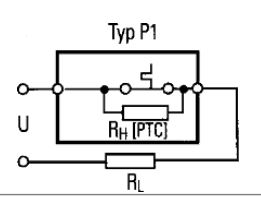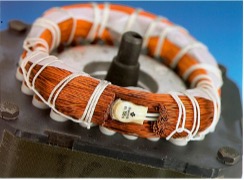CP1 |
SP1, SP1-600N |
KP1 |
 |
 |
 |
| Switching type | NC contact CP1 latching | NC contact SP1 latching | NC contact KP1 latching | |
| not automatically resetting | ||||
| Insulated: with insulation protection cap | no | Yes | yes | |
| Temperature | ||||
| Nominal switching temperature (NST), in 5 K steps [°C] | 60 – 180 | |||
| Tolerance Range -Standard- Tol[ [K] | ± 5 | |||
| Reverse Switch Temperature (RST below NST) UL [K] Reverse Switch Temperature (RST below NST) VDE [°C] |
|
|||
| Tension | ||||
| Operating voltage range from … [VAC] | 100 to 250 | |||
| Rated voltage AC [VAC] | 250 (VDE), 277(UL) | |||
| Current/switching cycles | ||||
| Rated current – cos φ = 1.0 [A] / [n] | 2,5 / 1’000 | |||
| Rated current – cos φ = 0.6 [A] / [n] | 1,6 / 1’000 | |||
| max. switching current -cos φ = 1.0 [A] / [n] | 10,0 / 1’000 | |||
| Rated current- cos φ = 0.6 [A] / [n] | 6,3 / 1’000 | |||
| Additional specifications | ||||
| High-voltage resistance [kV] | — | 2 | ||
| Total bounce time [ms] | < 1 | |||
| Contact resistance (according to MIL-STD R5757) [mΩ] | £ 50 | |||
| Vibration resistance 10 … 60 Hz [m/s2] | 100 | |||
| Compressive strength of the switch housing [N] | — | 600 for SP1 600N | — | |
| Suitable for installation in protection class | I | I + II | I + II | |
| Impregnation resistance | suitable | |||
| Available Licenses and Approvals | ||||
| please specify | IEC, VDE, UL, CSA, CQC, SP1 600 N IEC,VDE only | |||
| Dimensions (standard) | ||||
| CP1 | SP1 | SP1 600N | KP1 | |
| Diameter Ø d [mm] | 9,0 | 9,4 | 10,0 | 9,4 |
| Overall height (with standard connection) h [mm] | from 4.5 | from 4.9 | from 6.6 | from 4.9 |
| Length of insulation cap l [mm] | — | 15,0; | 17,0 | 13,0 |
| Standard stranded wire connection: | 0.25 mm2/AWG 22 | |||
| Functional circuit diagram | ||||
 When the switch is opened, the current flows through the PTC heating resistor and heats the switch so that it remains switched off until the voltage is removed. |
||||
| CP1 | SP1, Sp1-600N | KP1 |
 |
 |
 |
Note
The data and information provided are based on tests and test series. They are intended as a guide, which is why there may be deviations for individual applications and uses. The suitability for a specific application must be checked by the user in each individual case.





